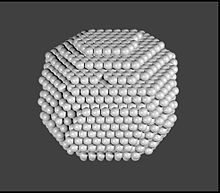
Back جسيم نانوي Arabic Наначасцінка Byelorussian Нанакластэр BE-X-OLD Наночастици Bulgarian Nanočestica BS Nanopartícula Catalan Nanočástice Czech Nano-gronyn Welsh Nanopartikel Danish Nanopartikel German

| Part of a series of articles on |
| Nanomaterials |
|---|
 |
| Carbon nanotubes |
| Fullerenes |
| Other nanoparticles |
| Nanostructured materials |
A nanoparticle or ultrafine particle is a particle of matter 1 to 100 nanometres (nm) in diameter.[1][2] The term is sometimes used for larger particles, up to 500 nm, or fibers and tubes that are less than 100 nm in only two directions.[2]: 394 At the lowest range, metal particles smaller than 1 nm are usually called atom clusters instead.
Nanoparticles are distinguished from microparticles (1-1000 μm), "fine particles" (sized between 100 and 2500 nm), and "coarse particles" (ranging from 2500 to 10,000 nm), because their smaller size drives very different physical or chemical properties, like colloidal properties and ultrafast optical effects[3] or electric properties.[4]
Being more subject to the Brownian motion, they usually do not sediment, like colloidal particles that conversely are usually understood to range from 1 to 1000 nm.
Being much smaller than the wavelengths of visible light (400-700 nm), nanoparticles cannot be seen with ordinary optical microscopes, requiring the use of electron microscopes or microscopes with laser. For the same reason, dispersions of nanoparticles in transparent media can be transparent,[5] whereas suspensions of larger particles usually scatter some or all visible light incident on them. Nanoparticles also easily pass through common filters, such as common ceramic candles,[6] so that separation from liquids requires special nanofiltration techniques.
The properties of nanoparticles often differ markedly from those of larger particles of the same substance. Since the typical diameter of an atom is between 0.15 and 0.6 nm, a large fraction of the nanoparticle's material lies within a few atomic diameters of its surface. Therefore, the properties of that surface layer may dominate over those of the bulk material. This effect is particularly strong for nanoparticles dispersed in a medium of different composition since the interactions between the two materials at their interface also becomes significant.[7]

Nanoparticles occur widely in nature and are objects of study in many sciences such as chemistry, physics, geology, and biology. Being at the transition between bulk materials and atomic or molecular structures, they often exhibit phenomena that are not observed at either scale. They are an important component of atmospheric pollution, and key ingredients in many industrialized products such as paints, plastics, metals, ceramics, and magnetic products. The production of nanoparticles with specific properties is a branch of nanotechnology.
In general, the small size of nanoparticles leads to a lower concentration of point defects compared to their bulk counterparts,[8] but they do support a variety of dislocations that can be visualized using high-resolution electron microscopes.[9] However, nanoparticles exhibit different dislocation mechanics, which, together with their unique surface structures, results in mechanical properties that are different from the bulk material.[10][11][12]
Non-spherical nanoparticles (e.g., prisms, cubes, rods etc.) exhibit shape-dependent and size-dependent (both chemical and physical) properties (anisotropy).[13][14] Non-spherical nanoparticles of gold (Au), silver (Ag), and platinum (Pt) due to their fascinating optical properties are finding diverse applications. Non-spherical geometries of nanoprisms give rise to high effective cross-sections and deeper colors of the colloidal solutions.[15] The possibility of shifting the resonance wavelengths by tuning the particle geometry allows using them in the fields of molecular labeling, biomolecular assays, trace metal detection, or nanotechnical applications. Anisotropic nanoparticles display a specific absorption behavior and stochastic particle orientation under unpolarized light, showing a distinct resonance mode for each excitable axis. [15]
- ^ Cite error: The named reference
epaXXXXawas invoked but never defined (see the help page). - ^ a b Cite error: The named reference
iupac2012was invoked but never defined (see the help page). - ^ Torres-Torres C, López-Suárez A, Can-Uc B, Rangel-Rojo R, Tamayo-Rivera L, Oliver A (24 July 2015). "Collective optical Kerr effect exhibited by an integrated configuration of silicon quantum dots and gold nanoparticles embedded in ion-implanted silica". Nanotechnology. 26 (29): 295701. Bibcode:2015Nanot..26C5701T. doi:10.1088/0957-4484/26/29/295701. ISSN 0957-4484. PMID 26135968. S2CID 45625439.
- ^ Shishodia S, Chouchene B, Gries T, Schneider R (31 October 2023). "Selected I-III-VI2 Semiconductors: Synthesis, Properties and Applications in Photovoltaic Cells". Nanomaterials. 13 (21): 2889. doi:10.3390/nano13212889. ISSN 2079-4991. PMC 10648425. PMID 37947733.
- ^ Cite error: The named reference
chae2003was invoked but never defined (see the help page). - ^ Cite error: The named reference
simo2011was invoked but never defined (see the help page). - ^ Cite error: The named reference
bati2015was invoked but never defined (see the help page). - ^ Cai W, Nix WD (September 2016). Imperfections in Crystalline Solids. Cambridge Core. doi:10.1017/cbo9781316389508. ISBN 978-1-107-12313-7. Retrieved 21 May 2020.
- ^ Chen CC, Zhu C, White ER, Chiu CY, Scott MC, Regan BC, et al. (April 2013). "Three-dimensional imaging of dislocations in a nanoparticle at atomic resolution". Nature. 496 (7443): 74–77. Bibcode:2013Natur.496...74C. doi:10.1038/nature12009. PMID 23535594. S2CID 4410909.
- ^ Guo D, Xie G, Luo J (8 January 2014). "Mechanical properties of nanoparticles: basics and applications". Journal of Physics D: Applied Physics. 47 (1): 013001. Bibcode:2014JPhD...47a3001G. doi:10.1088/0022-3727/47/1/013001.
- ^ Khan I, Saeed K, Khan I (November 2019). "Nanoparticles: Properties, applications and toxicities". Arabian Journal of Chemistry. 12 (7): 908–931. doi:10.1016/j.arabjc.2017.05.011.
- ^ Carlton C, Rabenberg L, Ferreira P (September 2008). "On the nucleation of partial dislocations in nanoparticles". Philosophical Magazine Letters. 88 (9–10): 715–724. Bibcode:2008PMagL..88..715C. doi:10.1080/09500830802307641. S2CID 40776948.
- ^ "Anisotropic Nanostructures". Mirkin. Retrieved 22 August 2021.
- ^ Sajanlal PR, Sreeprasad TS, Samal AK, Pradeep T (16 February 2011). "Anisotropic nanomaterials: structure, growth, assembly, and functions". Nano Reviews. 2: 5883. doi:10.3402/nano.v2i0.5883. ISSN 2000-5121. PMC 3215190. PMID 22110867.
- ^ a b Cite error: The named reference
ADARS108952was invoked but never defined (see the help page).